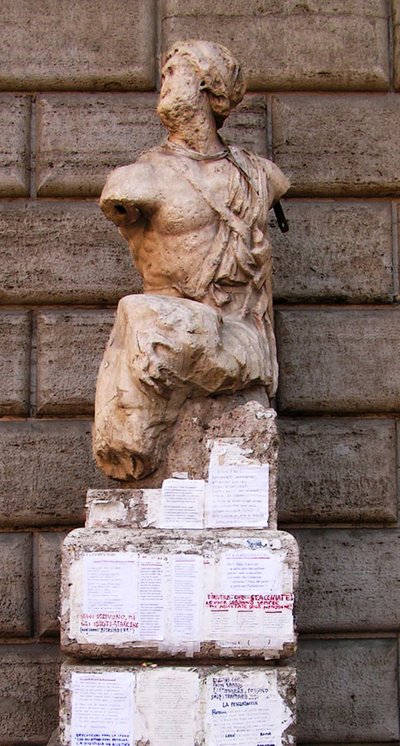Public Satire in Rome
Brendan Small

Photograph courtesy of Peter Heeling
noun
a satire or lampoon, originally one displayed
or delivered publicly in a public place.
In 1501, Cardinal Carafa set up a statue known as Pasquino in the Piazza di Parione in Rome. It became the center of an annual ritual where literati affixed satirical poems, often in Latin, to Pasquino’s base. Anonymous, bitingly caustic verses in Latin and Italian were soon posted year-round by learned and ordinary Romans, lampooning life, politics, and the elites. The poems were avidly consumed by literate and illiterate Romans alike, as citizens listened to them being read aloud. Pasquino became the mouthpiece of common Romans for expressing social and political tensions. Even today one can visit the Pasquino statue to find contemporary verses criticizing the government.

Pietro Aretino (1492-1556)
[London: J. Wolfe, 1588]
Rare Books Collection
Mystery surrounds the etymology of the name “Pasquino.” In the mid-1500s, Ludovico Castelvetro determined the epithet came from a sharp-tongued tailor. Nineteenth century scholars surmised the name was inspired by the character Pasquino from Poggio Bracciolini’s famous joke book Facetiae, a “sarcastic and humorous man.” Pietro Aretino offered another explanation in the prologue to La Cortegiana. Aretino facetiously explained that the statue was born from an illicit union between the Muses and vagabond poets.

[Roma: Jacobus Mazochius, 1512]
Rare Books Collection
Each year the best hundred or so verses from the annual festival were collected and printed in a volume like this one. Giacomo Mazzocchi published the inaugural collection of Pasquinades in 1509. This collection is from 1512, when Pasquino took on the role of Mars, proclaiming “I am Mars, yes I am.” His personification referenced the war of the Holy League against France, and many poems from this year talk of war.

Celio Secondo Curione (1503-1569), editor
[Basilaea]: Eleutheropoli, 1544
Rare Books Collection, Berlin Collection
As the Inquisition heated up in the early 16th century, the church cracked down on pasquinades in Rome, ultimately pushing the tradition to other printing centers in Europe. This edition was printed in Basel, disguised under the pseudonym “Eleutheropolis,” meaning “free city” in Greek. The alias suggests that publishers feared an adverse reaction from the Inquisition for its criticism of the curia. One notable entry is Erasmus’s satiric dialogue Julius Exclusus, which mocked Pope Julius II—known for his luxury as well as his wars—for struggling to enter heaven:JULIUS: What the devil is this? The doors don’t open?
Somebody must have changed the lock or broken it.
GENIUS: It seems more likely that you didn’t bring the
proper key; for this door doesn’t open to the same key as a
secret money-chest.

Celio Secondo Curione (1503-1569), editor
[Basilaea]: Eleutheropoli, 1544
Rare Books Collection, Berlin Collection
The second volume of this publication is a vibrant testimony to the anti-clerical polemics prevalent in mid-fifteenth-century Europe. This book contains prose from prominent German humanists like Erasmus of Rotterdam and the Protestant Ulrich Hutton. On display is Erasmus’ satire against the viri oscuri —monks, theologians, university men—whom he lampoons to inveigh against the everyday corruptions of the Church.Etching with engraving
Claudio Duchetti, publisher
1581
From the Speculum Romanae Magnificentiae
After Pope Adrian IV placed Pasquino under surveillance in 1522 to curtail anti-papal satire, other “talking statues” appeared. Posted verses often put multiple statues in dialogue, forming them into an academy called the “Congress of the Wits”—a network of dissenting, untraceable voices. This etching depicts Marforio, sometimes considered a “little brother” of Pasquino. Marforio, Pasquino and their colleagues created an early form of “social” media subversion, a comments section of sorts that continues to echo through the centuries.
Engraving
Orazio de Santis or Cherubino Alberti, engraver, after Giovanni Battista de’Cavalieri et al.
Andrea and Michelangelo della Vaccheria or Goert van Schayck, publisher
1614 or 1621
From the Speculum Romanae Magnificentiae
I am not (as I seem), the crippled Babbuino, without hands or feet,I am not even the ape of Niccolo Zoppino, with obscene and strange exotic parts,
But I am that most famous Pasquino, and I make the most prominent men shiver. And I astonish the out of towners and my fellow citizens
When I compose in vernacular, or in Latin.
My persona was shaped in this way
By the blows I take from here and from there
For happily revealing their sins,
But as long as I have my voice I do not care,
Even if the rest of my body perishes,
I will continue to speak the truth,
And the people who are offended must deal with it.
Because if stupid people do not want to keep their sins to themselves,
Who is going to stop me from telling them.
Translated by Brendan Small

Engraving
Antonio Lafreri, publisher
1550
From the Speculum Romanae Magnificentiae
Pasquino was dressed up each year for his festival in different costumes. In this engraving, we see several examples of the various props used to put Pasquino into character. The idea to dress up the statue likely came from Pliny’s Natural History, which speaks of a statue of Hercules in the Forum Boarium that was “arrayed in triumphal vestments” for triumphal processions (HN 34-33). In 1511, Pasquino was dressed as Grief, mourning the death of Cardinal Carafa, the statue’s patron.
